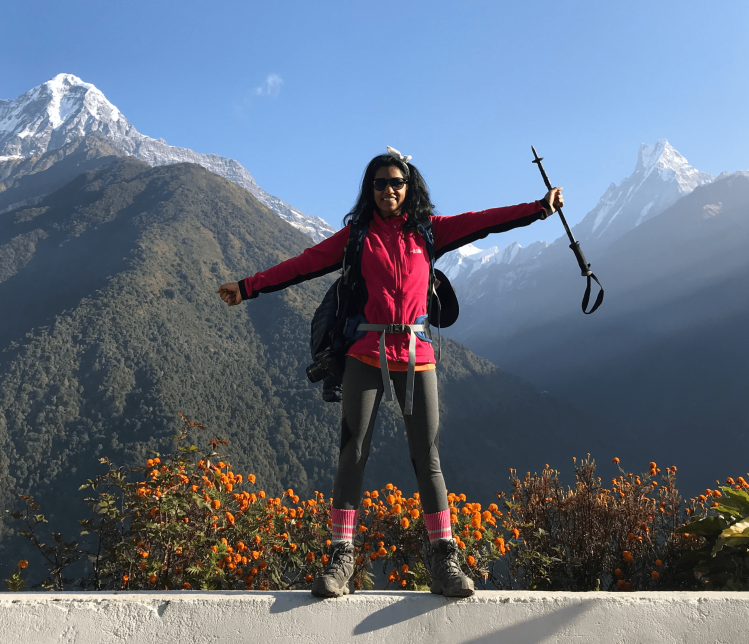
After months and months of preparing and training, I completed a relentless 9-day trek to Annapurna Base Camp in November 2018, along with 26 others in my group. Thanks to the incredible generosity of all our sponsors, we have managed to raise approximately £430,000, which will help Sense International continue doing its amazing work for deafblind children and their families throughout the world.
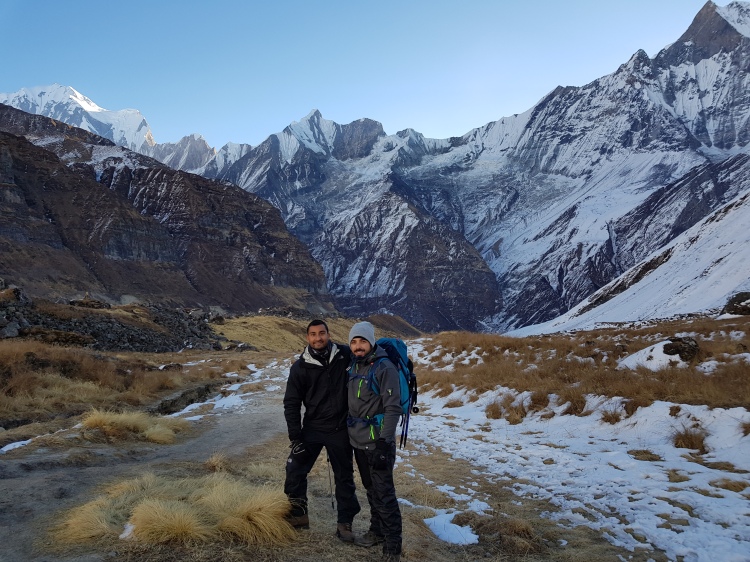
Trekking up to Annapurna Base Camp was one of the best yet most challenging things I’ve ever done – it has helped me to discover the strength of my body, my mind, and ignited within me a new passion for trekking and a desire to push myself further. It has exceeded my expectations and rewarded me with great new friendships and treated me to the most amazing vistas, from trekking alongside rice paddy fields, through tiny villages, mountain valleys and within dark forests. It wasn’t easy, but the spirit among the group kept everyone motivated – and regular rest periods (I listened to my body), helped me through. Here’s a day-by-day account of what went down, illustrated by photos, plus a list of essentials to pack if you’re doing the trek yourself (bottom).
LOCATION & PERSPECTIVE
Annapurna is a group of mountains in the Himalayas in north-central Nepal. We trekked to Annapurna Base Camp at 4,130m, taking in its unique and incredibly spectacular setting, amidst the majestic peaks of Annapurna South (7,219m), Annapurna I (8,091m), Hiunchuli (6,441m), Gangapurna (7,454m), Annapurna III (7,555m) and Machhapuchhre (6,993m).
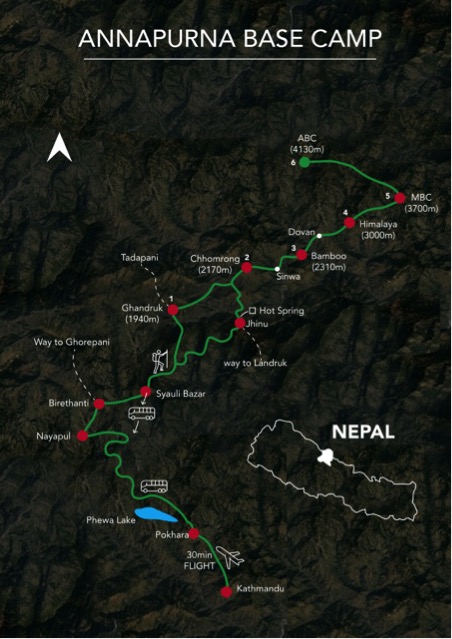
THE TEAM
Our group of 27 ranged in age from 24 to 65 years old, with more than 50% of the trekkers over 55 years old. There were 3 father and son/daughter pairs and 7 couples in this global team, which drew together trekkers from the UK, Australia, Canada, Singapore, Italy and Liechtenstein. Our full entourage came to 48 including the 5 local guides and their assistants and 16 porters, all local Gurung people of north-central Nepal. We were under the able leadership of our local Nepalese chief guide called Basu.
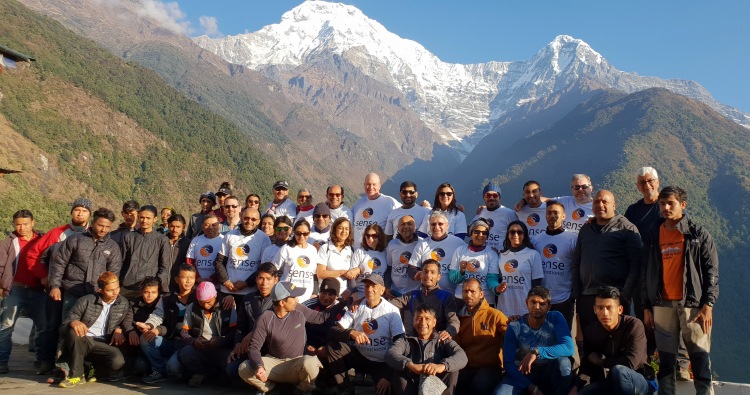
DAY 1 (18 November) – Nayapul to Ghandruk 1,940m
The whole group united in Pokhara for the start. We loaded our bags onto the roof of a people carrier and made a 2-hour car journey to the starting point of the trek at Nayapul (1,010m). The ride was so bumpy we wished we’d been given protective helmets! The rest of our entourage, including the assistant guides and porters, were waiting for us at the starting point. Everyone was muted and deep in thought as there was a sense of excitement coupled with a bit of nervousness amongst our group about the big task ahead and most probably the questionable living conditions we’d encounter over the coming days. We watched in awe as the porters used rope and rolled up old rice bags to secure two of our heavy 20kg backpacks on each of their own backs.
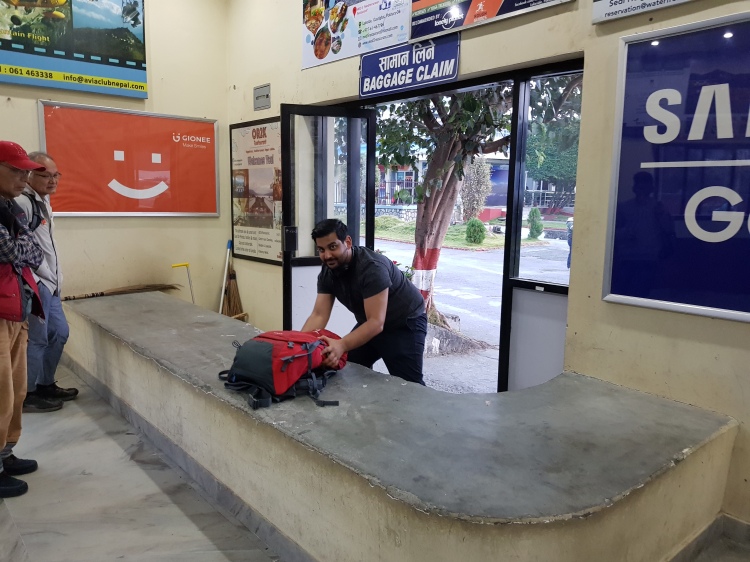
We set off on a dust road at around 11.30am. The weather was glorious; the sun was out and so were the bottles of sun cream. An hour into the trek we stopped for a coffee and to reflect on the lush greenery surrounding the small townships and rice paddies that we had passed. Little did we know of the endless uphill steps that would greet us shortly after our coffee break.
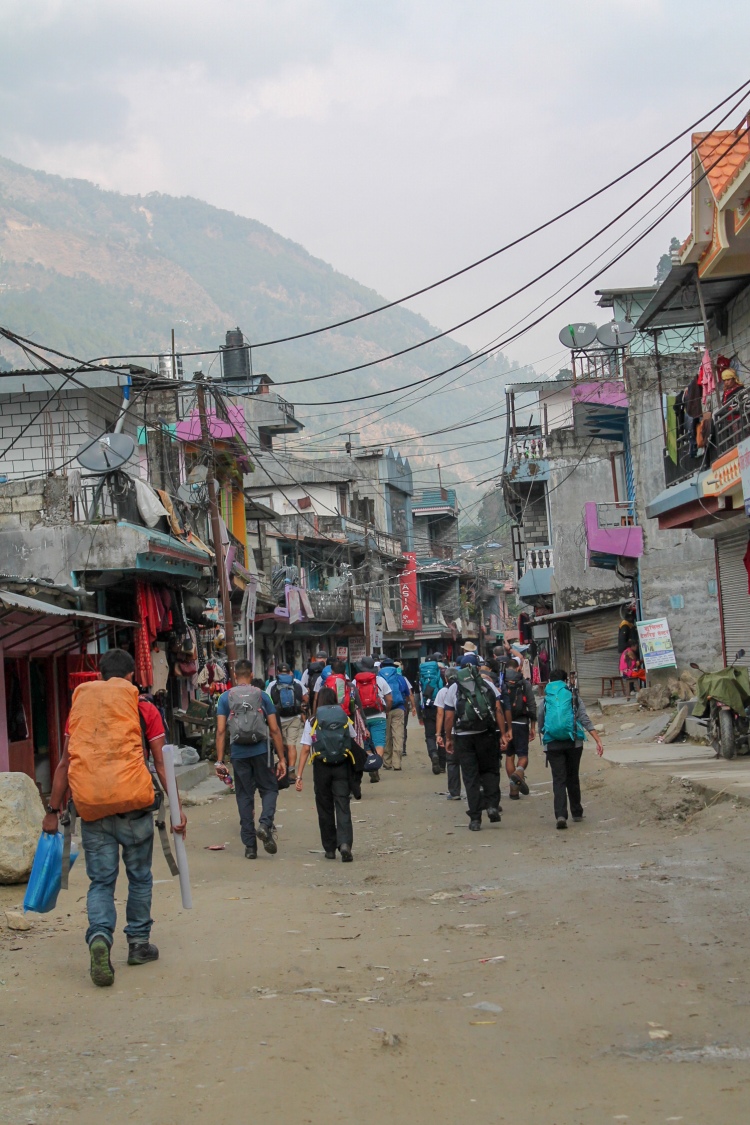
We followed the trail along the Modi River until we started hiking up a winding path to reach a place called Kimche for lunch; stir-fried rice with vegetables – subsequently voted the worst meal of this trek. Thankfully we’d packed a couple of mini bottles of Sriracha hot sauce, which helped the mouthfuls go down a little easier. Considering it was our first meal, we were even more nervous about what we’d be fed this week.
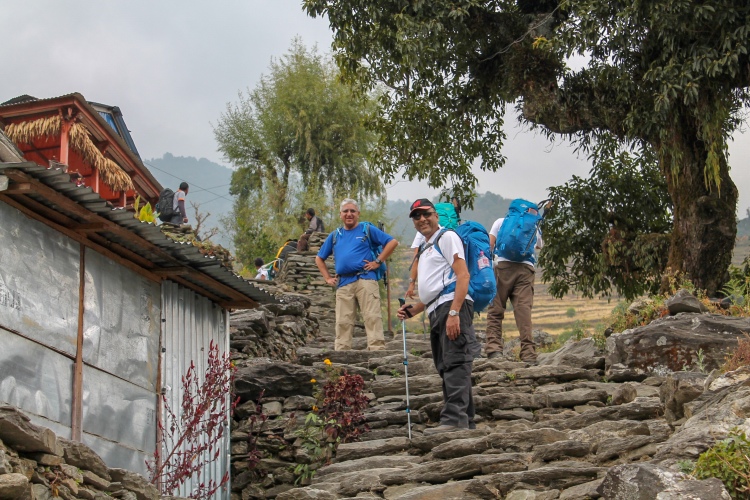
After lunch the trek continued to ascend towards Ghandruk. Some of us found the first day really challenging and slow going which meant we ran out of daylight towards the end of the day. We had to complete the rest of the day’s walk in darkness – it was eerie, being in a completely silent forest at that time of the day, but provided a very good chance to test those head torches. All in all we had climbed an equivalent of 400 flights of stairs on the first day. The thought on everyone’s mind was that whoever classed this as a ‘moderately difficult’ trek wasn’t thinking very clearly. We were questioning what we’d got ourselves into. On the upside, we were astounded that the porters managed to do the exact same route as we did, but with at least 40 kg loaded on their backs, and in significantly less time than we took.
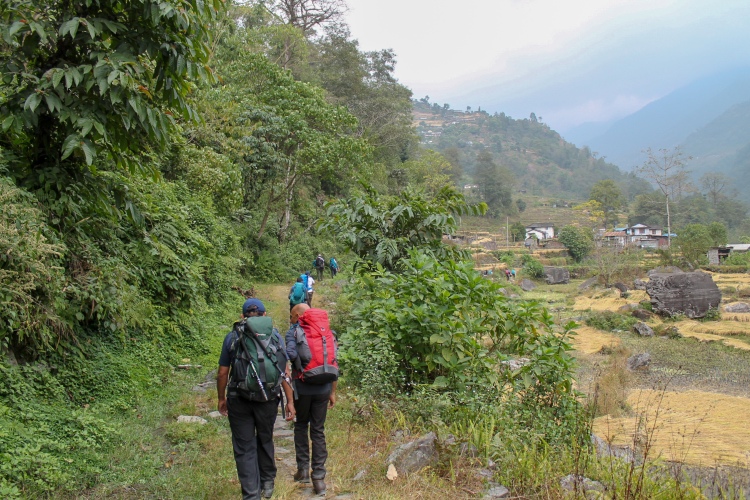
We arrived at our first tea house accommodation in Ghandruk having gained 900m on day 1, at approximately 6.30pm. Tea houses are essentially small, basic hostels in local villages offering both a place to sleep as well as a home-cooked meal. Most of the tea houses are owned, managed and inhabited by local families. They are all very basic, and the standards of service and facilities offered vary significantly between one tea house and the next. In the ‘bedrooms’ were three or four wooden bed frames with a thin mattress on each. Every night we would unfurl our sleeping bags on top of the mattress and clamber inside. The facilities got more basic and fewer as we ascended to villages at a higher altitude and the rooms got colder.
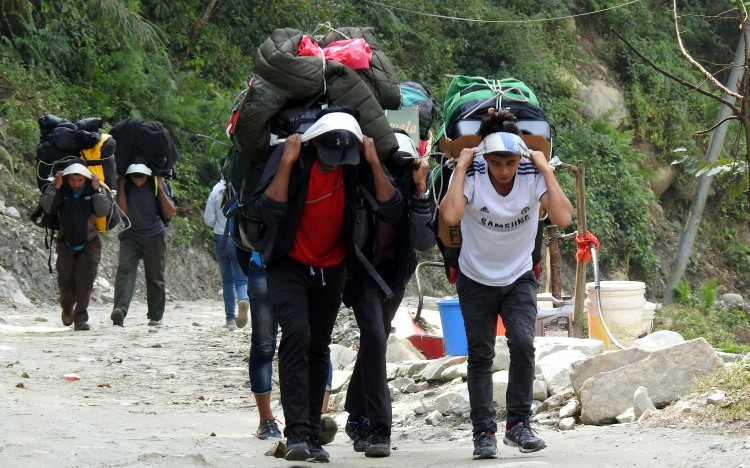
Everyone was completely shattered following a tougher than expected day of trekking immediately after a long-haul flight; so after a traditional Nepalese thali dinner we all retired early.
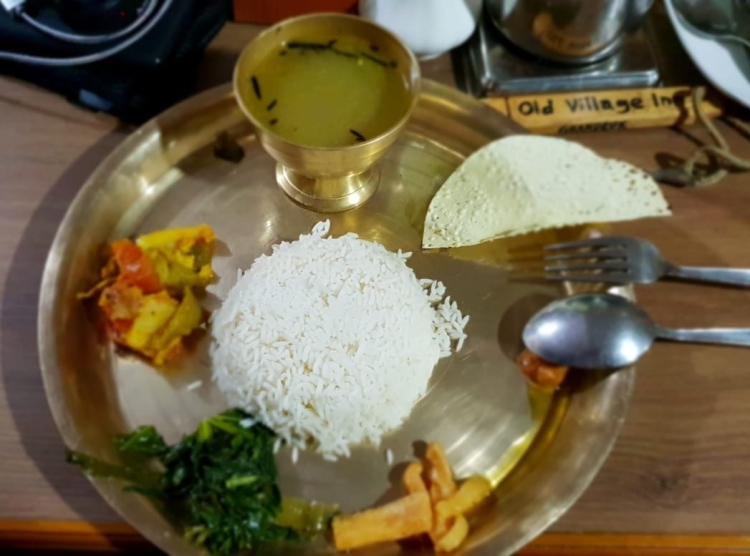
There were at least three people in a room (sometimes 5) – it was tight and there was definitely no space to swing a cat! There wasn’t any hot water coming from the shower so a few of us persuaded the owner to boil some water in a kettle for us – a bucket shower it was. The snorers in our group (each vying for the top spot) maintained their orchestral performance throughout the night depriving some of us from much needed sleep and rest – the flimsy, thin bedroom walls were no match against the nightly performance!
DAY 2 (19 November) Ghandruk to Chhomrong 2,170m
With the first day’s trek behind us and armed with a (mostly) good night’s rest in clean mountain air, we were ready to embark on our second day’s challenge, comforted by the knowledge that today would be easier than yesterday as we were only going to end up 250m higher. The early risers amongst us managed to catch a glimpse of the snow-covered mountains in the Annapurna Range far in the distance at sunrise, before the view was hidden by the clouds rolling in from the valley floor.
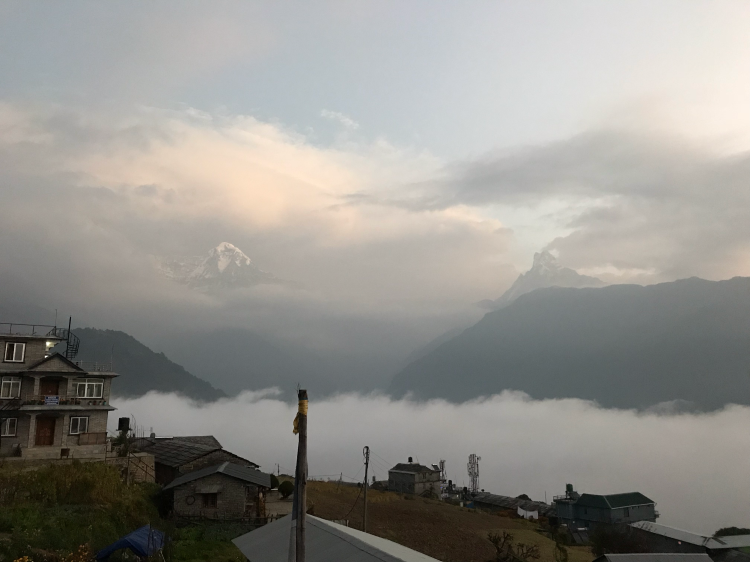
After a hearty breakfast (a boiled egg, curried potatoes and pancakes) and a quick stretch and warm up to loosen the muscles from the previous day’s trek, we left Ghandruk at about 8.00am, passing many children getting ready to go to school in this little village. The trek ascended for an hour up to Ghandrukkot Hill where we had a mini-picnic over cups of black/ginger tea.
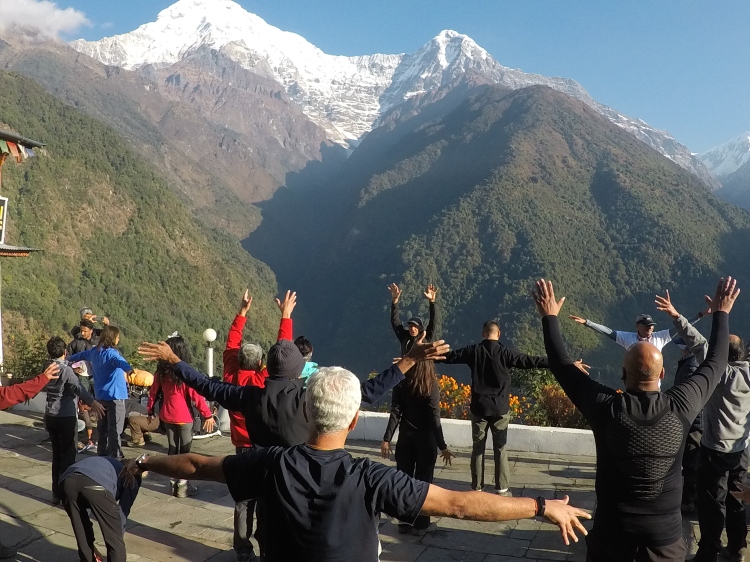
We prepared ourselves for a very steep descent down to the bed of Kimron River to our lunch stop. Having navigated almost 2,000 stony steps down to the river bed, almost everyone shared the view that downhill trekking was not much fun and strenuous on the knees.
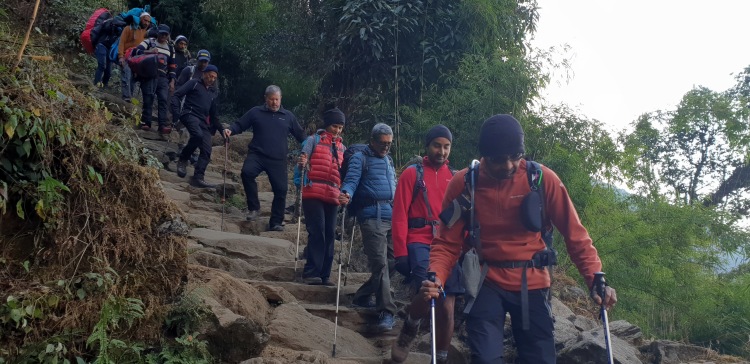
After a couple of hours walking, everyone enjoyed the lunch served in a very pleasant tea house not very far from the river bed and valley floor. During lunch the discussion centred around the unexpected 600 metre ascent that we needed to ready ourselves for – so much for an easy trekking day that we had anticipated when we started off this morning.
Sure as night follows day, we were greeted by another steep ascent comprising of 2,500+ steps to Chhomrong, a quaint village located on top of a ridge.
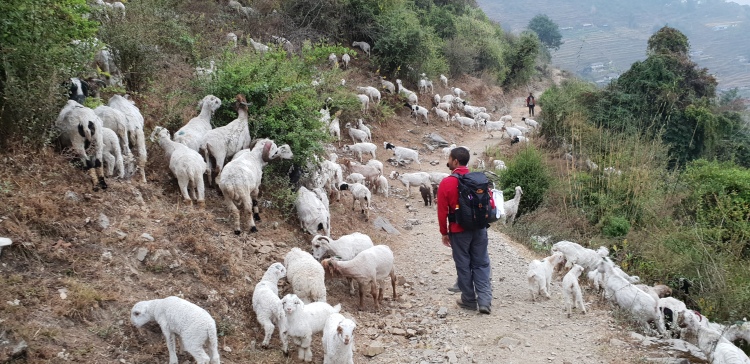
It was only day two – morale was low. The group was totally exhausted having laboured through thousands of steps and the mood for rebellion was in the air. There were no facilities on the trek so we’d all become accustomed to peeing in the wild or in a hole in the ground, and those trusty rolls of biodegradable loo paper were our saviours for the trip. Showers on this day were limited to a maximum of two minutes as there was not enough hot water for everyone, but very few people complained as it was just too cold to utilise the full two minutes – as soon as the sun went down, the outside temperature quickly dropped.
We got our first close-up silhouetted night view of the snow-capped Annapurna South and Machhapuchhare (commonly known as Fishtail Mountain) towering above the village of Chhomrong. It was a majestic sight, difficult to forget in a hurry. To warm up against the chill at night we decided to break open a bottle of local Nepalese rum to make a hot toddy. Before we knew it the beers and hot toddies were flowing and it became a party with everyone merrily singing and dancing around the dining table to local Nepalese songs, including the guides and porters. Letting our hair down allowed for a huge improvement in morale within the group.
DAY 3 (20 November) – Chhomrong to Bamboo 2,130m
It was 6.00am, dark and really cold outside but already the camp was stirring with a lot of activity. Everyone was out with their cameras and smartphones to catch their first real glimpse of the sunrise over Annapurna South and Machhapuchhare. There was a lot of excitement as people jostled for photo opportunities – it was a truly magnificent site. The temperature rose as soon as the sun was out; clear blue skies and 16°C were forecast today – perfect for the day’s trekking.
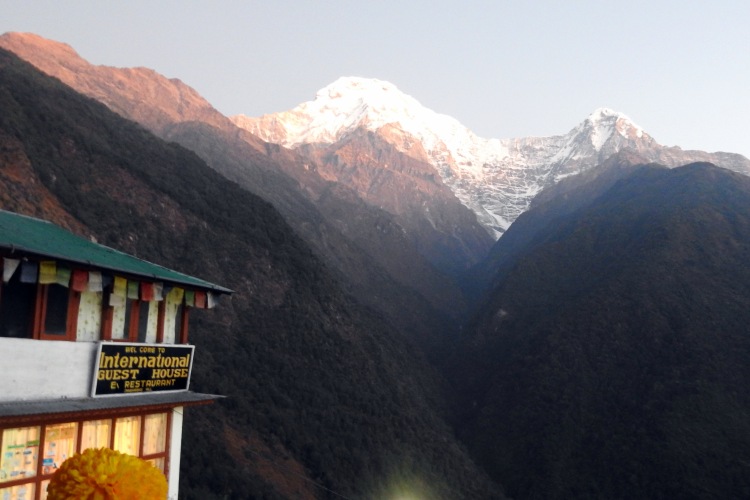
Breakfast was another feast, consisting of a boiled egg, curried potatoes and the traditional Gurung fried bread with lashings of masala tea and black coffee – our tastiest breakfast yet. After breakfast, it was a challenge to get everybody to line up for a group photo but there was a distinct upbeat mood within the group today.
The trail out of Chhomrong descended via 2,500+ large stone steps to the Modi river bed which we crossed using a swaying suspension bridge. There was yet another uphill climb on a rocky trail to Sinuwa (2,350m) where we took a break at one of its tea houses to catch our breath over lunch.
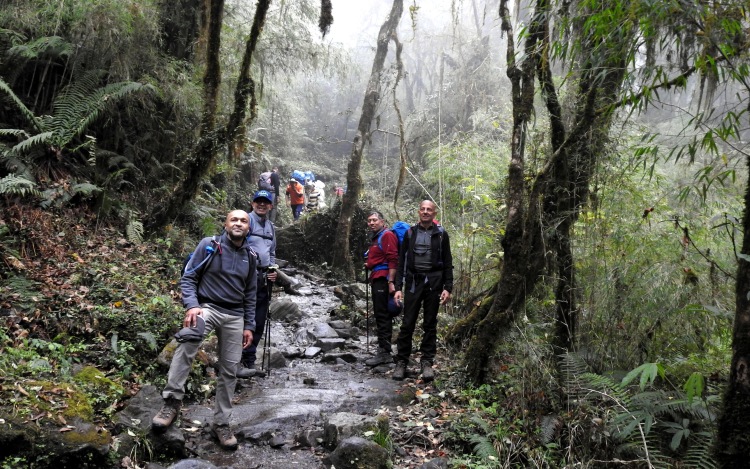
The trail continued uphill passing through a beautiful rhododendron forest to a place called Kuldi, which was once a British sheep-breeding project. It was all downhill from Kuldi across a long, steep staircase passing through a dense bamboo and rhododendron forest to arrive at a small hamlet called Bamboo.
DAY 4 (21 November) – Bamboo to Himalaya 3,000m
The trail continued to ascend through dense forests where we got to see troops of Langur monkeys jumping from tree to tree. Today we walked through thick fog so cameras didn’t see much action. We had not seen any motorised transport since we set off three days ago; the trail was littered with mule droppings, as mules are the main transport mechanism at this altitude; or sheer human strength.
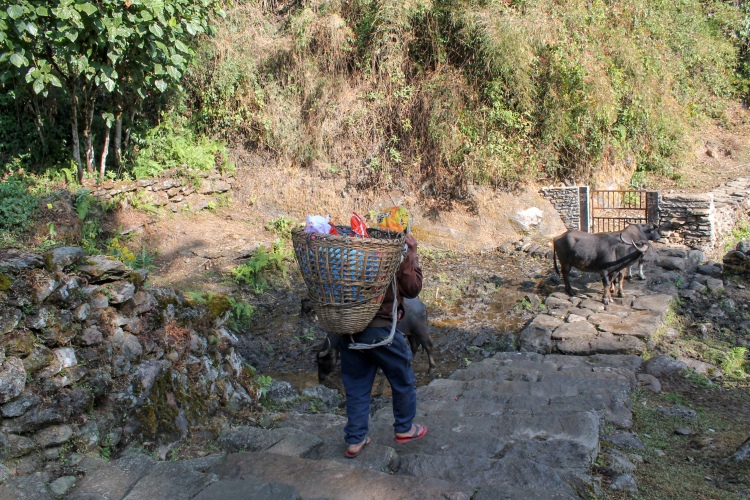
After walking for 7 hours, and having ascended 900m in total today, we finally reached a collection of three tea houses in what appeared to be the hamlet of Himalaya. Our accommodation was grandiosely named the Himalayan Hotel but it was just another tea house with fewer facilities than yesterday. I hadn’t showered in three days – the thought of a freezing shower and stripping off in the cold was too difficult – so my biodegradable baby wipes saved the day.
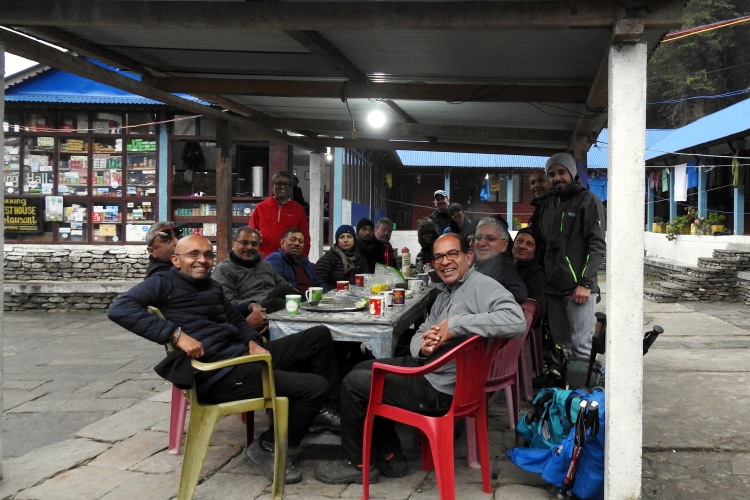
Although there was a chill in the air, we sat outside in the courtyard, under a corrugated roof shelter sipping tea and coffee; some of us playing cards over a beer whilst others content with having a chat about the day’s event. We were too tired to unpack our bags and freshen up before dinner.
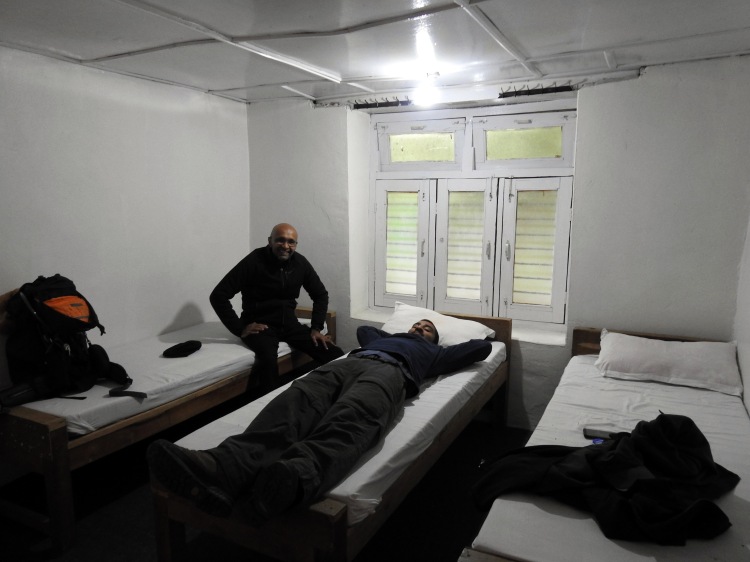
Dinner was the usual spread in a tightly packed and cosy dining area – 27 plates of Nepalese dal bhat thali, plus an extra 21 for the porters and guides. It is amazing what the chef was able to conjure up for dinner in such a small kitchen area in a remote location – but it tasted delicious.

DAY 5 (22 November) – Himalaya to Machhapuchhre Base Camp (MBC) 3,700m
We had been warned the night before, during the usual dinner briefing, to expect an uphill trek all the way to MBC which would be our highest overnight resting place on this trek. Today we had to ascend a full 700m. With heads slightly thumping (the first sign of altitude sickness), we set off towards MBC at 8.00am after the usual boiled egg and potato curry breakfast. The sun was out yet again to give us another gorgeous day, but it was not to last. The weather changed as we went up through the valley towards Hinko Cave with clouds rolling up from the valley floor making it very foggy. The trail passed over a couple of small precarious log bridges crossing a stream of ice melt from the mountains above.
After a 4-hour ascent we arrived at a place called Deurali, high above the cloud-line, where we relaxed for a couple of hours to enjoy an al-fresco lunch underneath a clear blue sky.
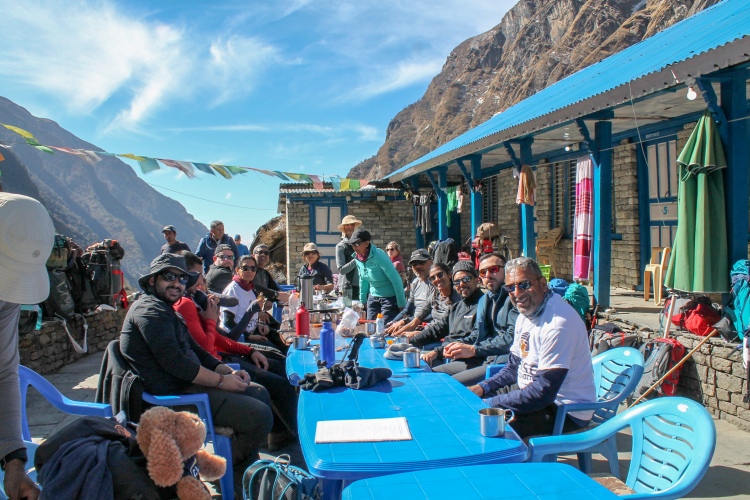
We were in for a treat – this place was known for the Nepalese Momo (a steamed dumpling with different kinds of filling – a bit like dim sum). Whilst lunch was being prepared, the game of cards continued; others relaxed and watch the world go by.
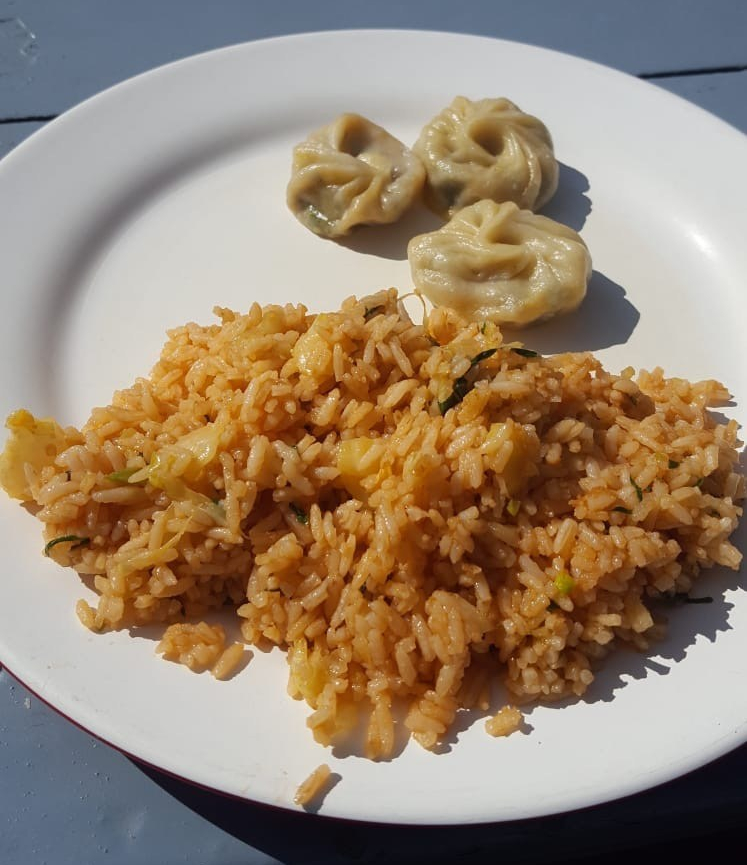
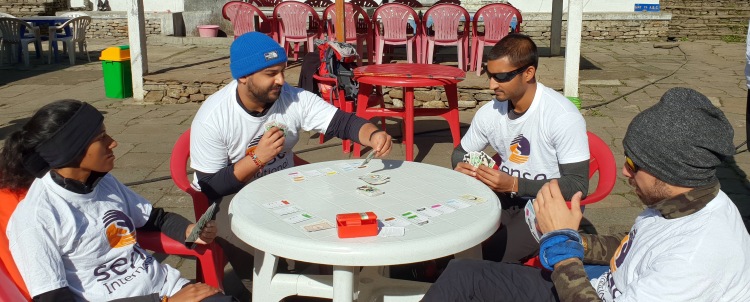
After lunch, the trail ascended gently through a fast-glacial river bed rising steeply over the mountain side. We found ourselves surrounded by giant snow-covered mountains. The sun rays reflected off the snow on the mountain to create a stunning view. But we had just entered the “Avalanche Risk Area” and the path was treacherous as we navigated across rocks covered by fresh snow fall from a recent avalanche. It was single file only. The mood was sombre. One wrong footstep and the snow beneath us could give way causing an injury or worse, making one slide right down the mountain side.
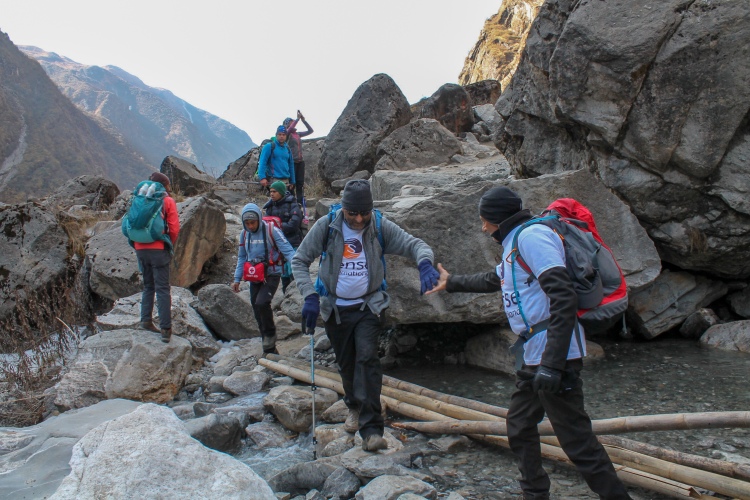
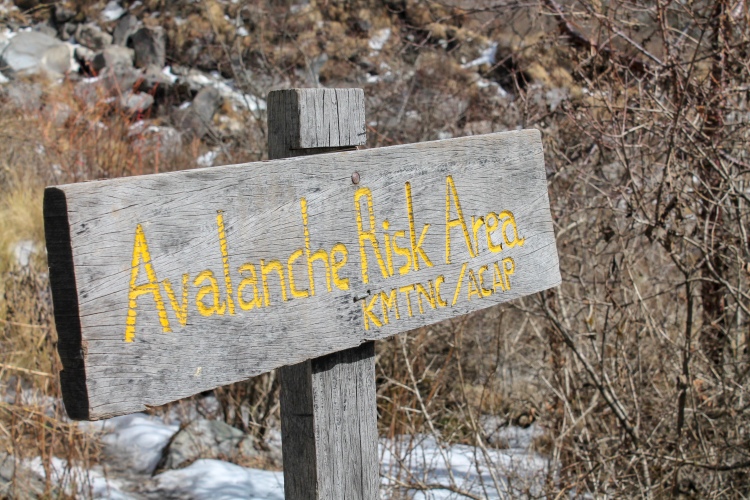
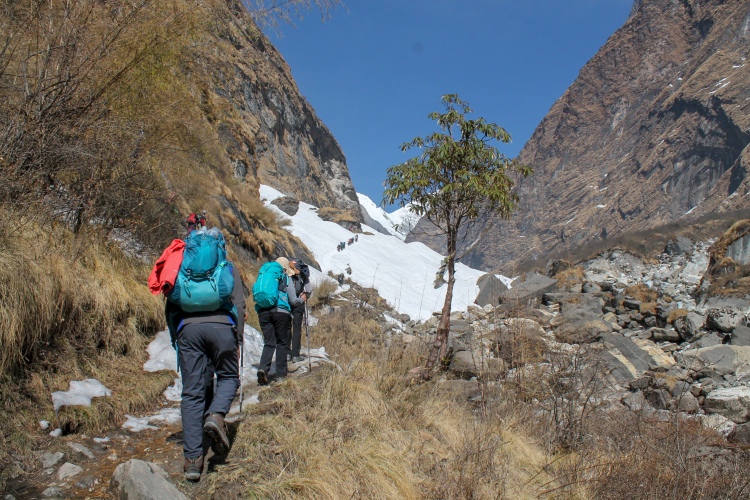
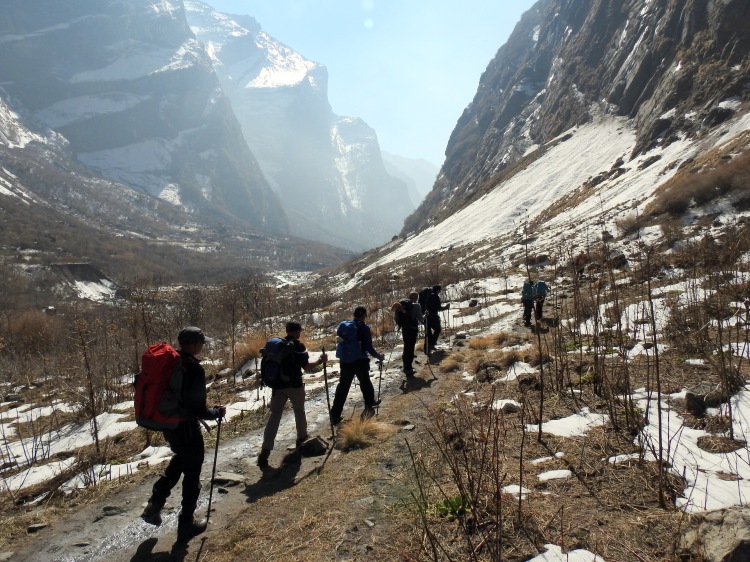
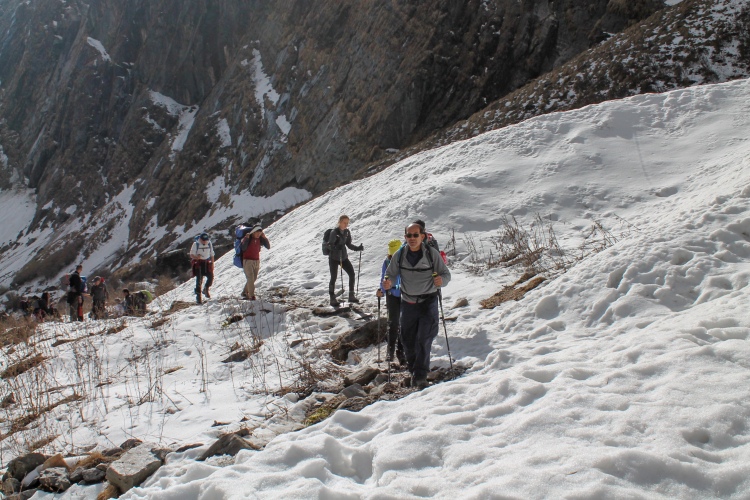
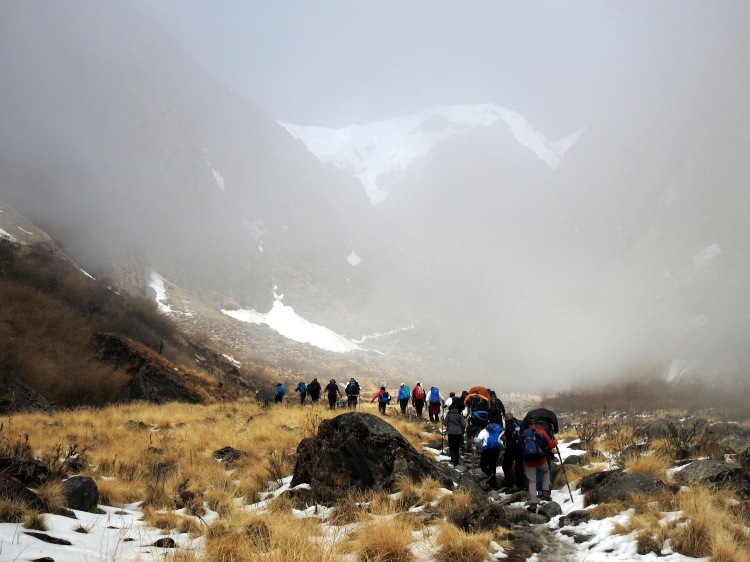
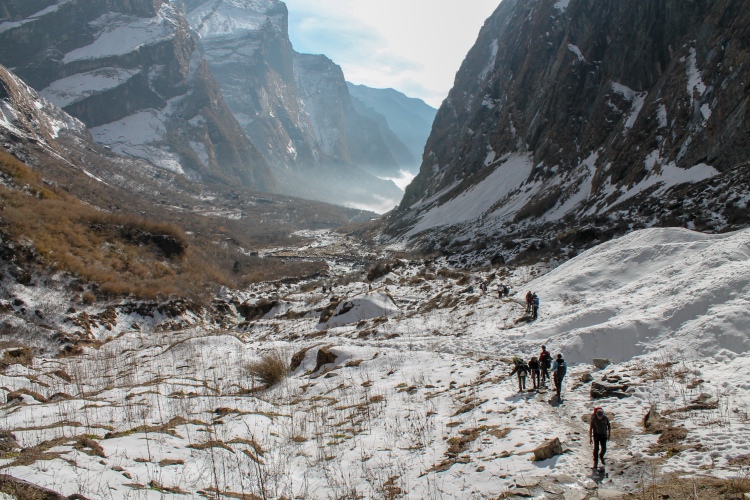
We all made it across safely but the effort and concentration of ploughing through lots of deep snow and icy sections was exhausting. Every now and again we heard the thunderous clap of an avalanche and snow falling down the mountainsides around us – it stopped everyone in their tracks to try to spot the white dust storm in the sky indicating the location of the avalanche.
The trek felt never ending. We asked the guides: “How much further? Are we there yet?” to which they gave their stock reply, “Not long to go now”. We finally arrive at MBC around 5.00pm and the view that rewarded us made it all worthwhile. We were completely surrounded by mountains, every way we turned; it almost looked pretend; like it was created as a backdrop for a theatre production. The humongous mountains (including Fishtail Mountain right ahead of us) had a way of making us all feel so small and insignificant. Despite the freezing cold and biting wind we posed and took lots of photos; staring in awe at the spectacle around us.
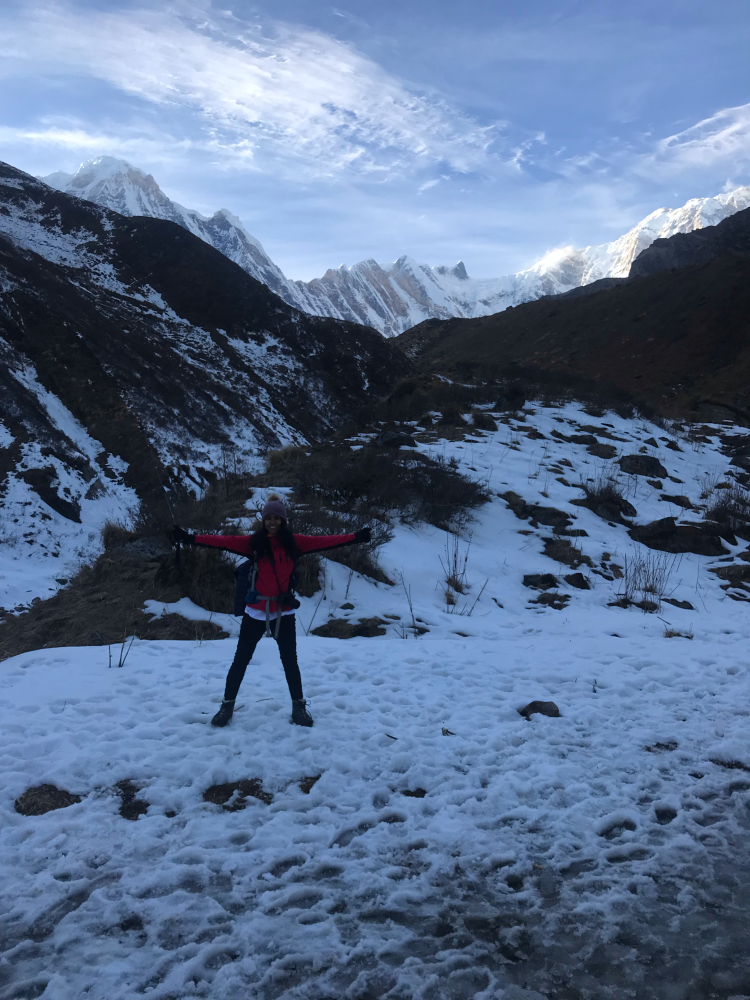
Although we were at a place labelled a base camp, it is not technically a base camp as it is forbidden to climb Machhapuchhre (Fishtail) for religious reasons.
The plan was to start trekking very early at 3am the next morning in order to get to Annapurna Base Camp just before sunrise. Some people had a splitting headache brought about by the altitude; most had mixed feelings of both apprehension and anticipation for what tomorrow would bring. We got busy organising and preparing ourselves for the early morning start. There was a sense of trepidation too: all that snow we’d just traversed would surely turn to ice overnight, and soon we’d be climbing back up it, yet it total darkness. Everyone was in bed by 9.00pm (today we were 4-5 to a room) although a lot of sleep was not to be had due to altitude, cold, anxiety and the ever-present night-time orchestra!
SUMMIT DAY 6 (23 November) – MBC to Annapurna Base Camp (ABC) 4,130m
It was 3am – pitch black and freezing cold outside – in fact the temperature was about minus 10c but it felt much colder due to the wind chill. But we had no option – we had to get out of our cosy sleeping bags as today was the big day when we would meet Annapurna. There was no time for a cup of tea/coffee or breakfast before we headed of.
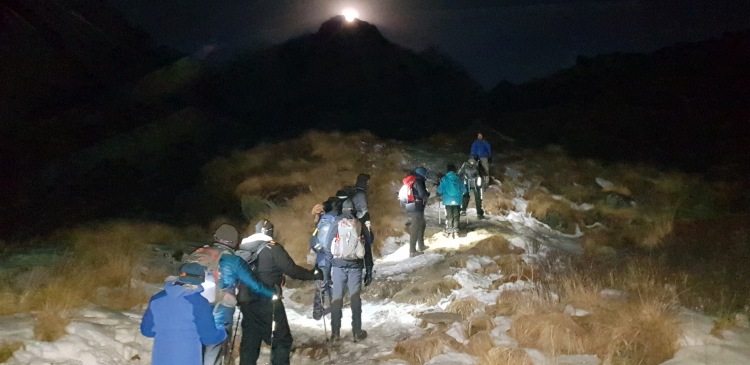
Although we had three layers of clothes on our legs, at least six on the top of our bodies, three pairs of socks, woolly hats, balaclavas and ski gloves, it still felt really cold standing in the biting wind whilst waiting for everyone to assemble before starting off.
To manage the safety of the group the guides split us into 2 groups, a faster pace and a medium pace group. Adorned with head torches we slowly made our ascent in a single file – wary as the path was covered with black ice – slippery and treacherous in some sections.
It was a full moon night with hardly any cloud cover to hide the millions of stars peppering the sky. Progress was slow on the icy surface and our ascent was c150m per hour. The wind chill made it feel colder, and our stops were limited to less than 2 minutes – to catch our breaths, clear our runny noses, grab a sip of water etc, so that we wouldn’t freeze – most finding it frustratingly difficult to accomplish these tasks in such a short time with so much clothing on!
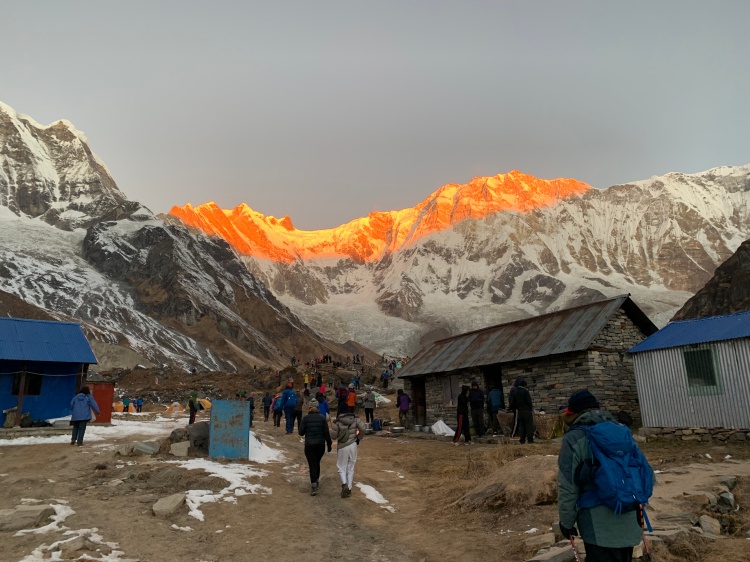
Just as the sun started rising, we entered an area called the Annapurna Base Camp Sanctuary. From here the views of the near-vertical south face of Annapurna towering above us were sensational. We had an unobstructed 360-degree panoramic view of Machhapuchhare, Annapurna South, Annapurna I, Annapurna III, Gangapurna, Hiunchuli and a few other peaks towering close to or above 8,000m. Annapurna Base Camp is a small area with a couple of tea houses, some research huts and expedition tents all on a cliff edge above a huge glacier moraine. We had finally arrived.
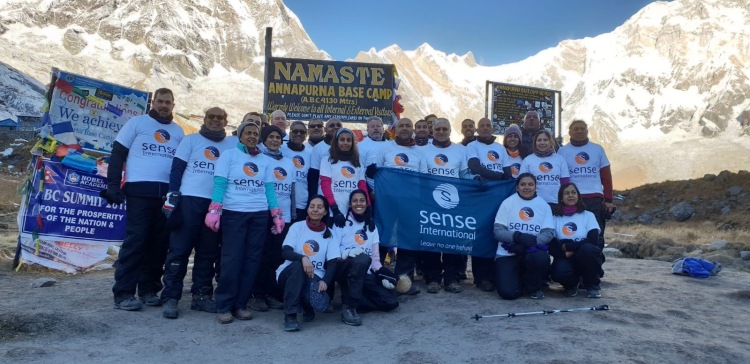
Everyone was on a high – hugs and high-fives all around; for some it was a very emotional moment – it finally sunk in that they had just realised their goal of trekking to Annapurna Base Camp having spent so much of their time in the last 10 months training and preparing for it.
There were 27 of us who embarked on this trek. 26 made it to ABC. It was a shame that the last one could not make it as he was about 45 minutes away from ABC but succumbed to altitude sickness, serious enough for the guides to make a call that it would be safer for him to turn back. All in all a great achievement for the entire group and for many individually it was one of the most rewarding day of the trek and a significant achievement of a lifetime. We took our time to watch the sunrise over Annapurna Sanctuary in the lap of the Himalaya range and let this significant achievement sink in.
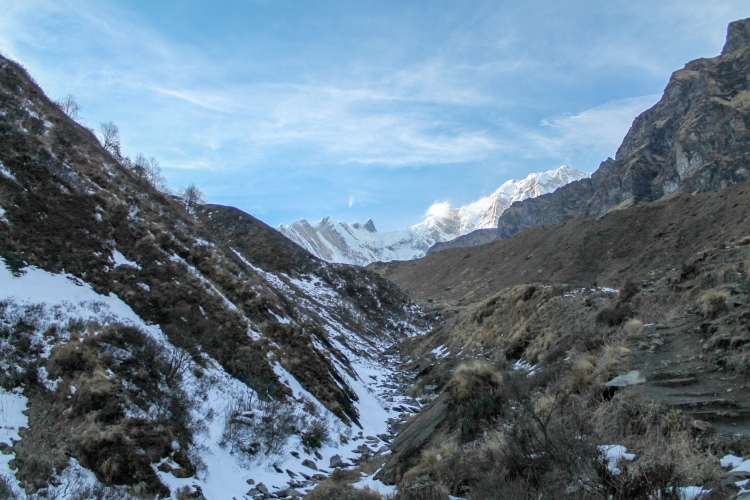
Before setting off on our descent to MBC we enjoyed a most satisfying and much needed cup of coffee and a piece of chocolate each. As the sun rose in the sky, the trek down to MBC became even more treacherous as the ice had started to melt. There was little foothold for our boots on the icy path and there were many tumbles and falls on the way down – luckily there were no serious injuries or broken bones. We arrived back at MBC for a well-earned breakfast before packing our bags in readiness for the descent.
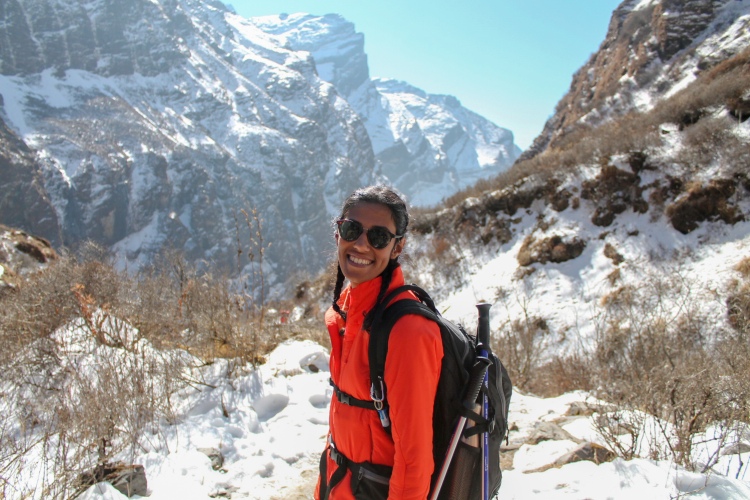
The mood in the group was very different now – we were on our way down and everyone was on a high from a personal goal fulfilled! We still had a long day ahead of us in order to get down to Dovan (2,500m). We passed through the “Avalanche Risk Area” again to arrive at Duerali at around 2.00pm where we enjoyed another great al-fresco lunch under clear blue skies.
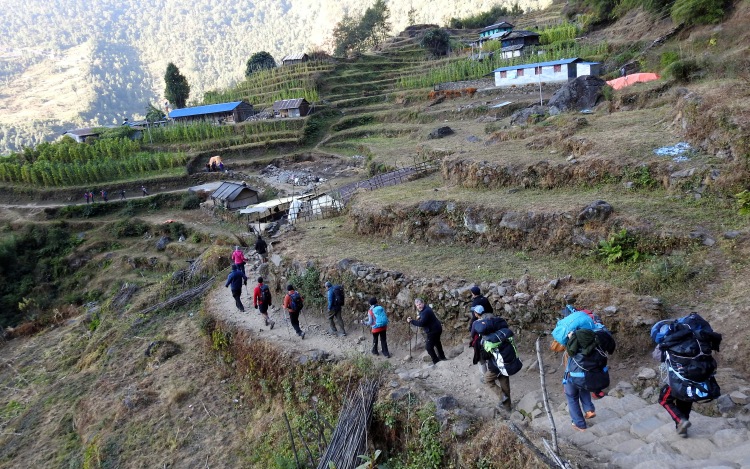
We continued our downward trek to Dovan, having to don for the second time that day our head torches, finally reaching Dovan in the dark for our overnight stop at around 6.00 pm. We had been walking since 3.00am – 15 hours in our boots! At Dovan we all had hot showers – for many of us it was our first shower in six days – at a cost of 200 rupees per person (about £1.50). Today was also a special day as we had a birthday boy amongst us. We cracked open a few beers, exchanged animated stories of the day’s events and for the first time ate something other than dhal bhat for dinner; we got pizza and chips as a reward for our hard day’s work. Sadly, we were all so shattered and unable to keep the celebrations going for too long. Everyone was tucked up in bed by 9.00pm.
DAY 7 (24 November) – Dovan to Sinuwa 2,360m
After a leisurely breakfast in Dovan – our first fried instead of boiled egg; oh what a treat! – we continued our trail downhill towards Sinuwa. Spirits were high and everyone had a spring in their step. After a 3-hour walk we arrived at Bamboo for a lunch break. We reached our accommodation in Sinuwa in record time around 4.00 pm.
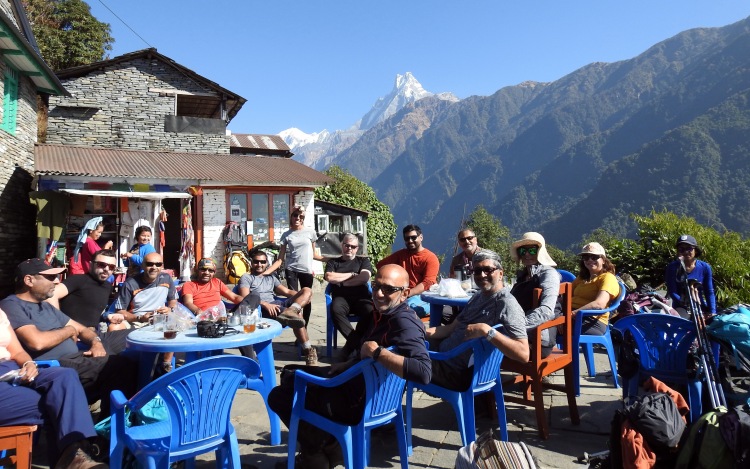
DAY 8 (25 November) – Sinuwa to Jhinu Danda 1,780m
We decided to start off early today as we wanted to get to Jhinu Danda as quickly as possible so that we could relax our tired muscles in the natural hot springs there. We left at 7.00am and after a couple of hours arrived at a beautiful outdoor spot, high on a mountain ridge, with panoramic views of the valleys below.
We continued our descent to Jhinu Danda, arriving in time for lunch and beers. After lunch we got into our swimsuits and ventured down through the forest for a 30-minute walk to the hot springs to spend a couple of hours unwinding in style. The setting of these hot springs was surreal – to one side was the fast-flowing Modi River and to the other was a dense forest. The locals believe the natural hot springs would aid the healing of the aches and pains that our bodies had suffered in the last few days.
DAY 9 (26 November) – Jhinu Danda to Pokhara
This was the final day of the trek. After breakfast we had a short 2.5-hour trek down to Sauli. To get there we had to walk along the second longest, swaying suspension bridge in Nepal about 350m long – it felt like walking down the aisle of an aeroplane in turbulence – for some it was unsettling. At Sauli, we thanked our porters for their incredible support and hard work, followed by an emotional farewell, before jumping onto our transport for the journey back to Pokhara.
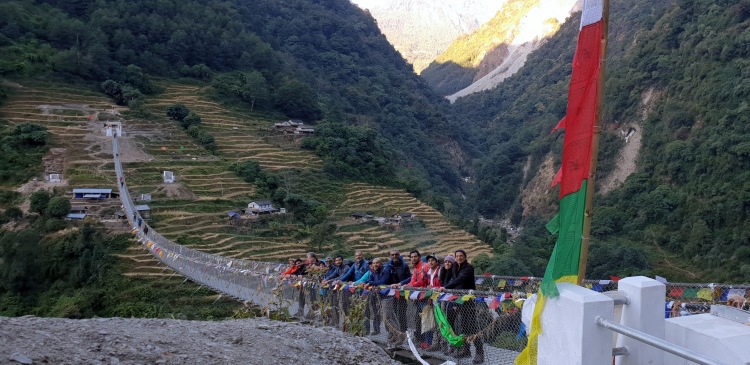
CLOSING NOTE
Everyone in the group is incredibly proud of their own personal achievement and journey over the last few months. We take away great memories forged along the Annapurna Base Camp trek together with countless stories and anecdotes to share with our friends and family. The best thing to come out of this trek are the new friendships and sense of camaraderie forged over the 9 days of trekking.
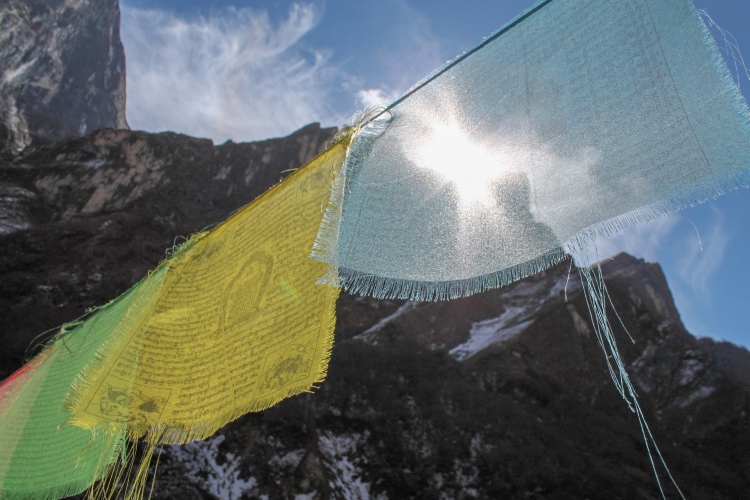
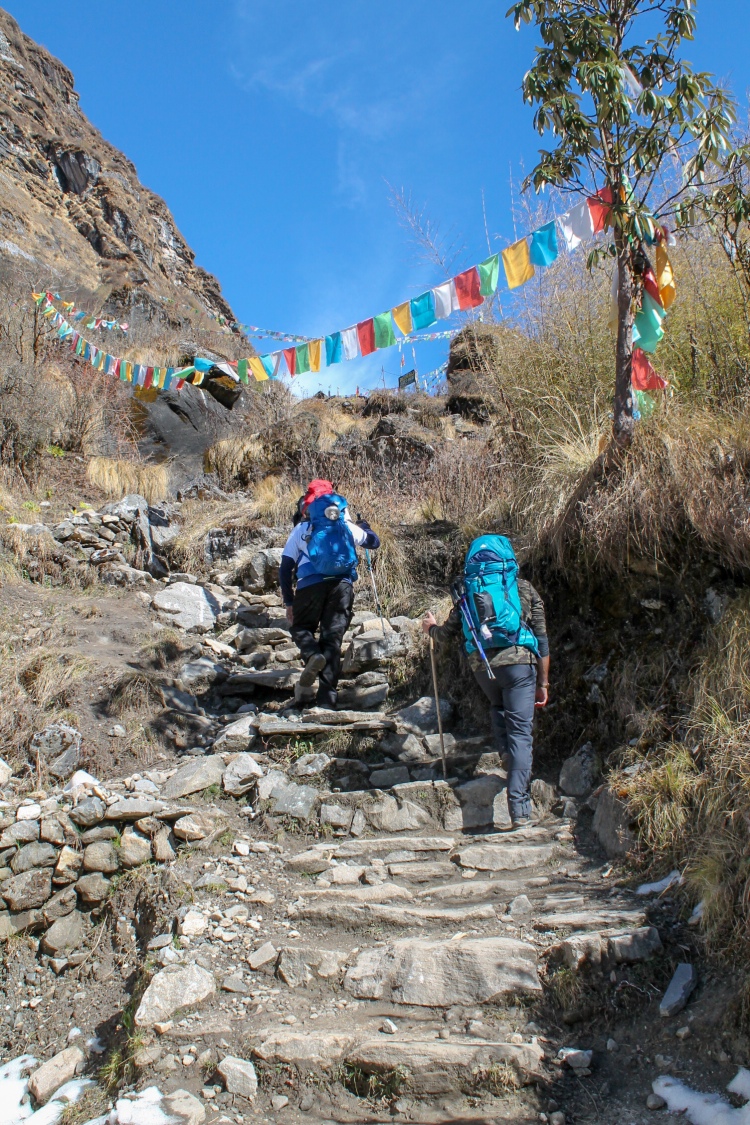
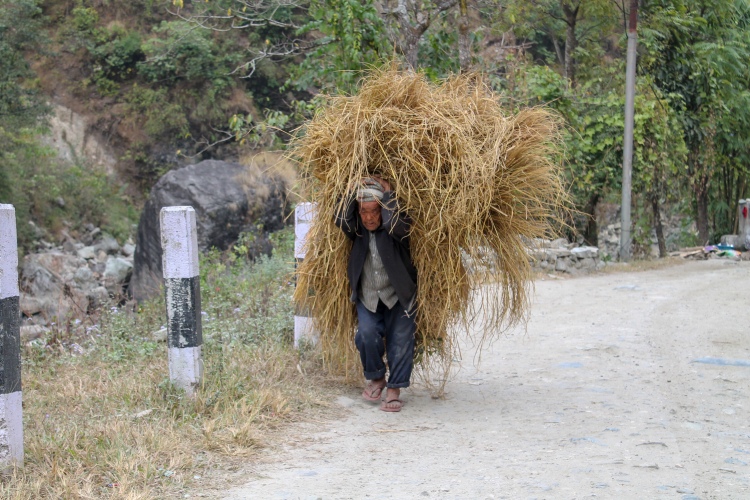
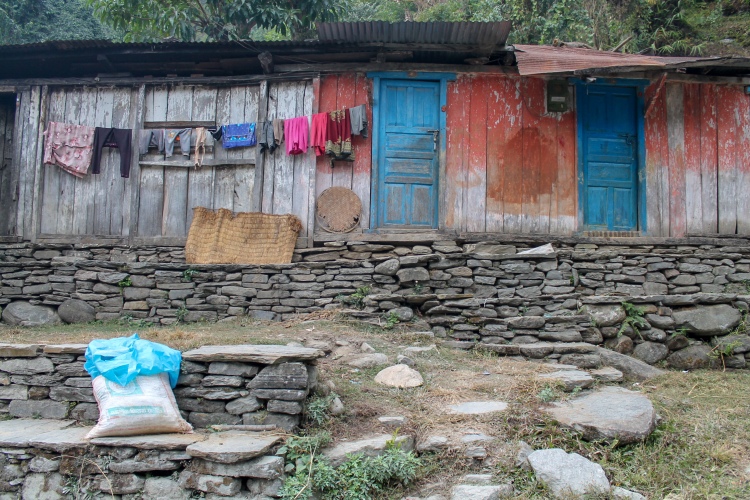
Together, we have managed to raise an extraordinary sum of money, currently standing at £430,000, for the deafblind which would not have been possible without the immense generosity of our donors.
We left a small piece of our hearts in Nepal but taken with us a rucksack full of memories. Kaushik, one of the team members has composed this poem below which sums up our feelings at the end of this incredible trek.
ASCENDING ANNAPURNA
Step by step, rock by rock
Heart thumping fast, tick-tock, tick-tock
You gaze to the sky, crystal clear blue
There she sits, majestically, like few others do
She holds court, so begins the drama
As others pay homage, in humble panorama
The flags in colour, salute her and flutter
Whispering sweetly “Go in Peace”, they mutter
The sun rises, showering her in golden glory
So ends a chapter, in your life’s story
Your heart and soul in union, this is karma
It’s just amazing, Ascending Annapurna
What to pack for Annapurna Base Camp
The main bag (70-100kg), which porters carry (make sure it’s wheel-less) should be waterproof, and contain the following items:
I’ve highlighted in red the things that were absolutely ESSENTIAL and inserted a few web links.
- Sleeping Bag – a 4-5 season plus (delivering comfort at -5C to -9C)
- Travel pillow (optional)
- Sleeping Bag Liner (silk or cotton) for extra warmth
- Comfortable shoes or trainers for the evening
- Good walking socks (1 pair for every 2 trekking days)
- Underlining socks (1 pair for every trekking day)
- Spare socks and underwear
- Warm thermal or base layer (2 pairs)
- Light trekking trousers (each one should give you 4-5 days wear)
- A couple of trekking shorts (or trousers convertibles into shorts)
- A couple of warm fleeces
- T-shirts & long-sleeved tops (1 for every two trekking days)
- Comfortable bottoms or spare trousers for the evenings
- A small wash-kit including any personal hygiene stuff
- Quick drying travel bath and hand towel (microfibre is best)
- Warm pair of wind and waterproof gloves with thin liner (ski gloves are excellent)
- An extra pair of lightweight fleecy gloves for lower altitude
- Padlock or means of securing/locking luggage
- Ear plugs
- Playing cards (Monopoly Deal is amazing), books, miniature travel games or something for entertainment
- Hand torch with spare batteries
- Mobile power bank for device charging (most tea houses charge you to use their electricity) – some in our group used solar chargers
- 1 spare re-useable water bottle
- Biodegradable wet wipes
- Medicine kit (see below)
- Spare chocolate bars, snack bars, trail mix, sweets or other snacks (the tea houses do have them available also, to buy)
- Colouring pencils/books/stickers/toys for the young Nepalese children you meet on the trek
Medicine bag comprising:
- Painkillers (avoiding those that include aspirin)
- Ibuprofen or other anti-inflammatory (not for asthmatics)
- Imodium or Lomita for diarrhoea
- Dehydration mix such as Dioralyte
- Antihistamines
- Antiseptic wipes and cream
- Plasters
- Elastic knee support
- Moleskin and/or ‘Compede’ for blister treatment
- Tiger Balm or equivalent
- Olbas Oil or Vicks breathing stick
- Throat pastilles or lozenges
Day rucksack (size 25-35 litres), which will be carried by you while trekking, containing:
- 2 -3 litre camelback hydration kit
- An inner wind-proof shell or light puffer jacket (to put on top on top of fleece but under waterproof jacket)
- Water and windproof jacket with a hood (Gortex)
- Waterproof trousers
- Warm woolly hat
- Scarf or snood
- Sun hat with good brim or a cap
- Sunglasses
- Head torch with spare batteries
- Passport, ticket and money
- Camera, film/memory cards and spare battery (remember to store your spare batteries in a warm place at all times as they lose power in the cold)
- Trekking poles
- Sunscreen (min factor 30)
- UV lip block
- Insect repellent
- Pot of Vaseline – extremely useful to prevent blistering and chaffing
- Hand sanitiser (one that clips on to your bag is handy) and wet ones
- Water purification tablets – these ones were great, couldn’t taste any difference
- Hydration tablets (I took ORS)
- Biodegradable toilet paper (special one which is bio-degradable)
- Pocket-size keyring Sriracha hot sauce bottle